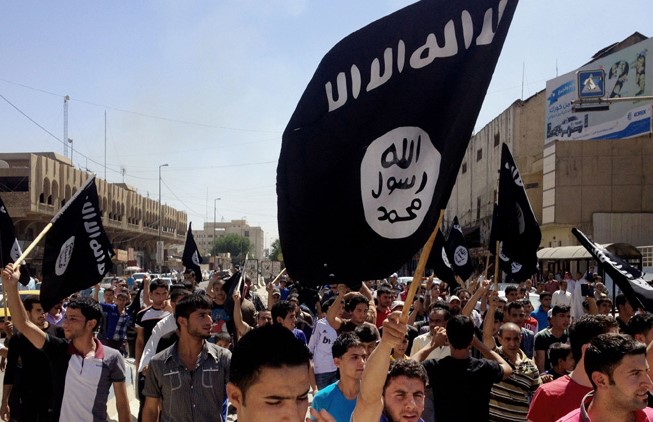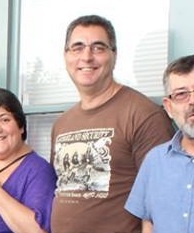AP photo
By
Rupen Savoulian
In Australia, politicians of all stripes are conducting a national conversation about the origins, rise and ways to challenge the fundamentalist militia Islamic State (IS).
This debate usually takes place within the context of understanding global terrorism. There are resources, such as the online magazine The Conversation, that examine the rise and nature of IS in a historical and political context. Since IS burst onto the scene in June 2014 with the capture of the northern Iraqi city of Mosul, that militia has stunned the international corporate media with its brutality. Numerous papers and forums have been dedicated to comprehending the conditions that gave rise to this particular group.
In Australia, former Prime Minister Tony Abbott, frequently referred to IS as a ‘death cult.’ Sometimes, he would mention this group as an ‘Islamist death cult.’ Firstly, let us clear up one misconception – let us do our best to avoid using the mistaken term “Islamic terrorism.” Let us approach the problem of global terrorism as an issue for all nations and communities. Let us avoid associating the civilisation, people and philosophy of the Islamic world exclusively with something as horrendous and repulsive as terrorism. No single civilisation or ethnic group has a monopoly on a propensity to commit acts of violence.
Secondly, Abbott’s obsessive and neurotic fixation on ‘death cult’ serves the purpose of overinflating his ego, exaggerating his importance in the fight against IS. Magnifying the menace and strength of the enemy, serves to increase the seeming courage of those confronting it. It also serves the purpose of distorting the nature of political debate – singling out the undoubtedly savage violence of IS all the while downplaying the serious problems that confront the Australian community.
For instance, domestic violence is at staggering proportions in Australia. One in five Australian women has experienced intimate partner violence. Former PM Abbott did mention this issue in his media releases, interviews and transcripts 43 times between September 2014 and May 2015. However, in the same period, he mentioned ‘death cult’ 346 times, and numerous backbenchers took up the same expression. He demonstrated his priorities while in office.
It is true that current Prime Minister Malcom Turnbull, has not used this expression. However, he uses more subtle, yet no less aggressive rhetoric, when denouncing the IS militants. He portrays this group as a unique, existential threat to the existence and values of our capitalist nominal parliamentary democracy. The phrase, while not recycled as frequently as before, nevertheless maintains its shock-value. Robert Manne, emeritus professor and vice-chancellor’s fellow at La Trobe university, attempted a more academic rendition of the ‘death cult’ theme in his article for The Monthly magazine, entitled “The Mind of the Islamic State: an ideology of savagery.”
Articles like Robert Manne’s are useful to be sure. They make for fascinating reading. They also maintain the uniqueness and singularly evil nature of this bizarre, ultra-sectarian militia outfit. The social experience of this death cult appears unusual and intriguing to us in the (supposedly) civilised West. Surely, the IS militia is something so irrational, driven by fanatical primal motivations and is so remote from our experience in the Christian-European West that it is beyond rational comprehension. Perhaps it is difficult for us to understand, because we have nothing to which to compare it, an analogue experience in the West.
Death cult? That’s not a death cult……..
In the smash-hit Australian movie from the 1980s, Crocodile Dundee, there is an iconic scene involving the title character, played by Australian comedian Paul Hogan. He and his girlfriend are confronted by a robber on the street, who demands that Dundee hand over his wallet, and pulls out a pocket-knife. Dundee, scorning the menace of the street mugger, states “that’s not a knife – that’s a knife!” He simultaneously draws out a large hunting knife, and the would-be mugger disappears. Let us use this particular approach with this subject.
You think IS is a death cult? Ok, it is – but the militants of this group seem as menacing as fluffy kittens compared to the group that set the gold-standard for death cults – the Legion of the Archangel Michael, a mass fascist party in Romania active throughout the 1930s and the early part of World War Two. The newly independent Eastern European nations, modelling their nascent political systems on the main Western democracies, such as Britain, underwent traumatic changes during the interwar years. The Legion was birthed and metamorphosed in this multilayered complex of competing economic, social and political pressures.
The Romanian Iron Guard – as this Legion was popularly known – was a large fascistic organisation that advocated the rebirth of the Romanian state as a pure, Christian, fascistic polity. They were following the larger and more successful examples of mass fascist parties in Nazi Germany and fascist Italy. However, they had characteristics that made them distinctive. Combining an ultra-fanatical interpretation of Eastern Orthodox Christianity, and modern political fascism, they believed that the way to overcome the economic and social dislocation of the Eastern European state was through redemptive violence.
The Greenshirted Iron Guard, set about purging Romania of all the influences that they determined were detrimental – Jews were massacred, anti-fascist Romanians murdered, synagogues burnt to ashes, labour and Communist organisations slaughtered – they combined a mythology of Christian martyrdom with racist doctrines to become a terrifying tornado of mass violence.
Romania in the 1920s and 30s was undergoing its own economic and social problems, with the majority of the ruling stratum orienting towards Britain as their political and economic model. Bourgeois parties were squabbling, forming and dissolving numerous coalitions; the King Carol II was nominally in charge, but the army remained the power behind the throne. Into this maelstrom emerged the Iron Guard.
Morbidly fascinated by ultra-violence, their slogans included “God is a fascist” and that the ultimate goal of the nation is the Resurrection of the Christ. Combining a harsh literal Christian spirituality with racial purity and political militancy, they became a large fascist party – and a death cult. Scorning parliamentary politics, they believed in the purifying qualities of violence and bloodshed.
Intending to establish a severe Christian theocracy – a Christian caliphate, if you will – the legionnaires of the Iron Guard unleashed their version of violent self-sacrifice, with the aim of rebirthing Romania as an exemplary Christian, racially exclusive and austerely Eastern Orthodox society. As Stanley Payne, emeritus Professor of History at the University of Wisconsin-Madison explained it, the Iron Guard insisted not only on maniacal violence and religious orthodoxy, but also on a supposed biological purity of the Romanian bloodline.
Prospective Legionnaires would perform grisly rituals of initiation – drinking the blood from the corpses of Iron Guard’s victims. To join the elite of the organisation – the death squads known as the Brotherhood of Christ – required that each new member slash themselves, bleed into a communal cup, from which each person of the direct-action squad would drink. Consuming blood in this initiation ceremony meant that the candidate was now inducted into the elite for life. There was no way out – not even in death. Wherever they went, the Iron Guard left behind a bloody trail of slaughter and destruction, seeking power and redemption by living their cult of violence and death.
The Romanian capitalist parties had hoped to domesticate and exploit the blood-drinking fanatics of the Iron Guard. To a certain extent they were successful. Whenever domestic opposition to the Romanian monarchist oligarchy erupted, the ruling class had a readily disposable weapon – send in the crazy people. By the early stages of World War Two, the military strongman, Marshal Ion Antonescu, stepped up as the chief in charge. He allied himself with the Iron Guard, used them and relied on them – but also kept them under close watch. By 1941, as the utility of the death cult as a political pawn evaporated, Antonescu demolished the organisation. However, its ideas and scattered membership lived on.
The Iron Guard were fascinated by death and the spiritual reawakening that accompanied it. Motivated by their fanatical interpretation of Eastern Orthodox doctrines to create God’s kingdom in Romania, that was combined with an insistence on racial purity and the resurgence of the nation through constant, maniacal violence and bloodshed. Now that was a morbid, ghoulish, ultra-violent death cult.
An honest conversation
I am not suggesting that we should not have a debate about the origins and nature of IS. I am not suggesting that one religion is better or worse than the other. I am not suggesting that religious extremism does not have any influence in the emergence of violent militia groups. I am stating that we need to have an open, honest examination of all the complex motivations – economic, political and religious – that interconnect and contribute towards the origin of apocalyptic, fanatical death cults.
Let us supersede the deceptive debate we currently engage in on the causes of terrorism, which focuses exclusively on the Western victims of death cults, but routinely ignore the victims of state-sponsored systematic violence by the major Western powers. Australian politicians should read the excellent article, published by the Bulletin of the Atomic Scientists, back in June 2014. Entitled “ISIS: the unsurprising surprise sweeping Iraq”, the author examined the material conditions, created by specific political decisions to go to war, that created a conducive atmosphere for the success of the IS militia group.
No need for empty slogans; no need to deploy jarring phrases like ‘death cult’ to get attention. It was a meaningful, insightful contribution to a necessary conversation about the current problem of terrorism, and its most recent emergence in the shape of IS. If we are going to use phrases, let us deploy them with consistency, and not just when it suits narrow, politically expedient purposes.
Is Australia at risk of a terrorist attack? Yes. But that threat is very remote. Professor Greg Austin, an expert in cyber-security and terrorism from the University of New South Wales, says that Australians are more likely to be killed by the police, or die in a domestic violence incident, rather than die from a terrorist attack. Indeed, the propensity to commit acts of violence goes the other way – with Muslim communities experiencing an increase in ethnically-motivated violence in this climate of surging Islamophobia.
In this environment of supercharged and exaggerated anxieties about terrorism, political and community leaders – and the mainstream media – have the responsibility to alleviate them, not inflame anxieties into a raging moral panic. Those who incite moral panic feed a climate of bigotry and prejudice – sentiments that are exploited by recruiters for militia groups such as IS.



No Comments Yet!
You can be first to comment this post!